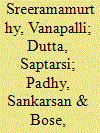|
|
|
Sort Order |
|
|
|
Items / Page
|
|
|
|
|
|
|
| Srl | Item |
| 1 |
ID:
136040


|
|
|
|
|
| Summary/Abstract |
Source localisation is a method to estimate position of a source. In case of acoustic source localisation (ASL), the location of sound source is estimated using acoustic sensors such as a microphone. In case of ASL, time difference of arrival (TDOA) from each pair of microphones is estimated. For any pair of microphones, the surface on which the TDOA is constant is a hyperboloid of two sheets. Then the source location is estimated at the point where all associated hyperboloids most nearly intersect. This concept has been used in our range in finding the point-of-burst of artillery shell using an array of sensors. In this paper, a simulation model has been developed to examine the applicability of acoustic source localisation for determining point-of-burst of artillery shells. The randomness in the model has been incorporated in terms of gustiness of downrange sea wind. The result of the simulation has been validated with trajectory data of projectiles tracked by radar. Finally, an acoustic sensor array-based setup has been developed and used for localising point-of-bursts.
|
|
|
|
|
|
|
|
|
|
|
|
|
|
|
|
| 2 |
ID:
138631


|
|
|
|
|
| Summary/Abstract |
From a military standpoint, a river is an area that should be avoided in a potential engagement because of lack of cover and the necessity of dividing the unit while crossing. Thus, a key point of a river-crossing operation is speed. Many efforts have been made to enable faster river crossing by improvement of tactics, techniques, and procedures (TTP). However, improvements in TTP are evaluated by modelling and simulation much less frequently than are the toe-to-toe engagements between two opposing forces, and to our knowledge, this is the first simulation model of brigade-level river crossing with engineering details. This study presents a simulation model of the river-crossing operation, applies real world parameters, and evaluates which tactics are preferable in a particular operational environments. This analysis has led to new operational methods of river crossing that have been suggested by experienced subject-matter experts. For instance, the current Republic of Korea Army Field Manual dictates to rotate river-crossing rafts in all situations, but our experiment suggests that no rotation is preferable when the width of river is less than 400 m based on the statistical analyses, which includes the regression-based meta-modelling and the ANOVA, of our simulation model that embodies the engineering details of river-crossing equipment.
|
|
|
|
|
|
|
|
|
|
|
|
|
|
|
|
|
|
|
|
|